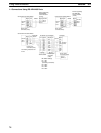
5-3SectionUsing Protocol Macros
68
Send Data
7 words from D00000 to D00006
K3N node No. : 00
CompoWay/F command “0101” (reads the K3N present value)
Number of send bytes
CompoWay/F command send data
(Variable type, read start address, 00, number of elements)
S:D00000
D00001
D00002
D00003
D00004
D00005
D00006
0007
0000
0101
000C
C000
0000
0001
Receive Data
Response code is stored.
The read data (in this case, the present value of K3N) is stored.
4 words from D00010 to D00013
D:D00010
D00011
D00012
D00013
0004
3. Executing the PMCR(––) instruction
4. For details on confirming operation, see Section 12 Tracing and I/O Memory
Monitoring in the CX-Protocol Operation Manual (W344).
• Transmission Line Tracing
The data in the send/receive messages flowing over the transmission line
(RS-232C or RS-422A/485) and the control codes are traced.
• I/O Memory Monitoring
Monitors send/receive data and the status of the various flags.
Using User-created Protocols
Use the CX-Protocol to
create protocols.
Serial
Communications
Board
PMCR(––)
CPU Unit
CX-Protocol
External device
Section references in the following procedure refer to the CX-Protocol Op-
eration Manual (W344).
1, 2, 3... 1. For details on designing protocols, see Section 4 and Section 5.
a) Create a communications sequence status transition chart.
b) From the status transition chart, divide the processing contents into se-
quence steps.
c) Determine the send/receive message contents.
2. Use the CX-Protocol to create and send a project (protocol data).
a) Creating a new project:
See 5.1 Creating a New Project or Protocol.
b) Creating a new communications sequence:
See 5.2 Creating a New Sequence or 7.1 Setting a Sequence.
c) Creating steps:
See 5.2 Creating a New Sequence and 8.1 Setting a Step.
d) Creating messages:
See 9.1 Setting a Message.
Note After creating messages, steps can also be created by specifying
message names.


















